by Humble Student of the Markets
Further to my last post (see Sell in May?) I am seeing more negative divergences that create more concerns for the bull case. The recent rally, which has been led by the golds and deep cyclicals, have all the appearances of a dead cat bounce rather than the start of a sustainable advance.
Last week, I suggested that traders should watch the silver/gold ratio for signs of a sustainable rally (see Watch silver for the bottom in gold). The idea was that silver, being the more volatile poor man's gold, should display positive relative strength against gold and lead a precious metal rally if these metals are in the process of making a sustainable bottom. Look at what's happened to the silver/gold ratio since then:
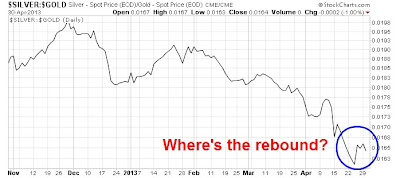
We can see how the oversold rally developed by analyzing the price charts of the gold and silver ETFs. GLD has certainly staged a classic capitulation and rally pattern to fill in the gap left by its recent freefall:
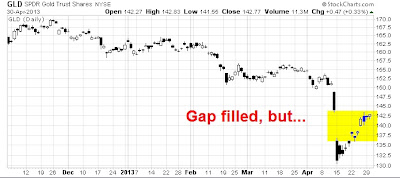
But what about silver? Sure, this poor man's gold rallied, but the rebound has been weak and the gap was not filled, which suggests to me that this advance is an oversold rally and the next major move in precious metals is likely to be down.
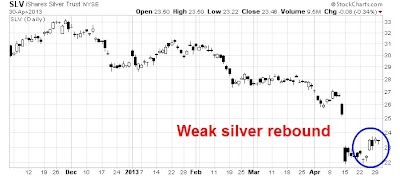
As confirmation of the bearish commodity trend, the entire industrial metals complex remains weak despite the rebound in gold and oil:
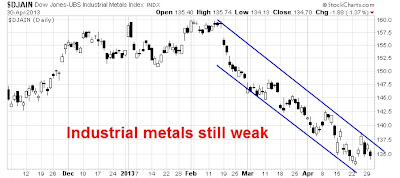
In my previous post, I also wrote about watching the AUDCAD currency cross rate, with the premise that the Australian Dollar is more sensitive to growth in China and the Canadian Dollar is more sensitive to growth in the American economy. A breach of the uptrend in this cross rate would would be a signal that the market's belief that Chinese growth is slowing, which would be negative for the global growth outlook. The breakdown in this currency pair cannot be regarded as good news for the prospects of Chinese growth.
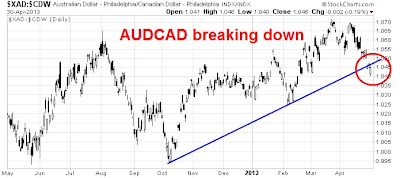
Another concern is the disappointing South Korean April exports, which were just released and missed expectations at 0.4% compared to estimates of 2.0%. The South Korean economy is regarded as cyclically sensitive as the country is highly exposed to trade with China and Japan.
In addition, Cullen Roche at Pragmatic Capitalism recently pointed out that the Citigroup Economic Surprise Index is turning down in every major region in the world. As a reminder, a economic surprise index reading below zero is indicative of more misses than beats on economic data. Falling surprise indices around the world suggests, therefore, that global economic growth is starting to stall.
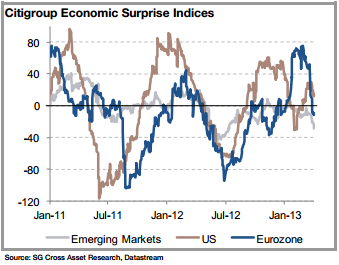
As we wait for the decisions of the Federal Reserve and ECB this week, it will be a test of market psychology of whether bad news is good news, i.e. economic slowdown will lead to central bank stimulus, which is bullish, or bad news is bad news.
Non-confirmation of SPX new highs
Moreover, with the SPX making new marginal highs, I am not seeing the breadth confirmations from the 52-week highs and lows. While these kinds of breadth divergences can last for months, it nevertheless raises a red flag about the sustainability of this stock market rally.

Here's another puzzle. If the stock market is making new highs, why is the VIX/VXV ratio (which I described in a previous post here and first pioneered by Bill Luby, see his original post) sitting at only 0.91, which is barely below my "sell signal" mark of 0.92? What is the term structure of the option market telling us?

This is not investment advice
One final point. I have outlined a number of negative divergences that suggest a bearish tone for stocks, but I have not outlined the timing of any trades. In my last post entitled Sell in May? I sketched out a number of likely triggers for to get more defensive. Since then, I have had a number of emails and other responses asking if and when I would write about when those events are triggered and, by extension, when it's time to sell or short the market.
Let me make this very, very clear: Those triggers are just a set of suggested triggers. It will be up to each individual reader to make up his or her own mind as to what to do if and when each event is triggered. Don't expect me to hold your hand and shout "sell" for you. You are responsible for your own portfolio and your own profit and loss statement.
For the readers who are waiting for me to tell when to buy or sell, I strongly suggest that you re-read my previous post about why the contents of this blog does not represent investment advice. This blog is a forum for discourse, not pre-digested investment or trading advice.
Cam Hui is a portfolio manager at Qwest Investment Fund Management Ltd. ("Qwest"). This article is prepared by Mr. Hui as an outside business activity. As such, Qwest does not review or approve materials presented herein. The opinions and any recommendations expressed in this blog are those of the author and do not reflect the opinions or recommendations of Qwest.
None of the information or opinions expressed in this blog constitutes a solicitation for the purchase or sale of any security or other instrument. Nothing in this article constitutes investment advice and any recommendations that may be contained herein have not been based upon a consideration of the investment objectives, financial situation or particular needs of any specific recipient. Any purchase or sale activity in any securities or other instrument should be based upon your own analysis and conclusions. Past performance is not indicative of future results. Either Qwest or Mr. Hui may hold or control long or short positions in the securities or instruments mentioned.
Copyright © Humble Student of the Markets












